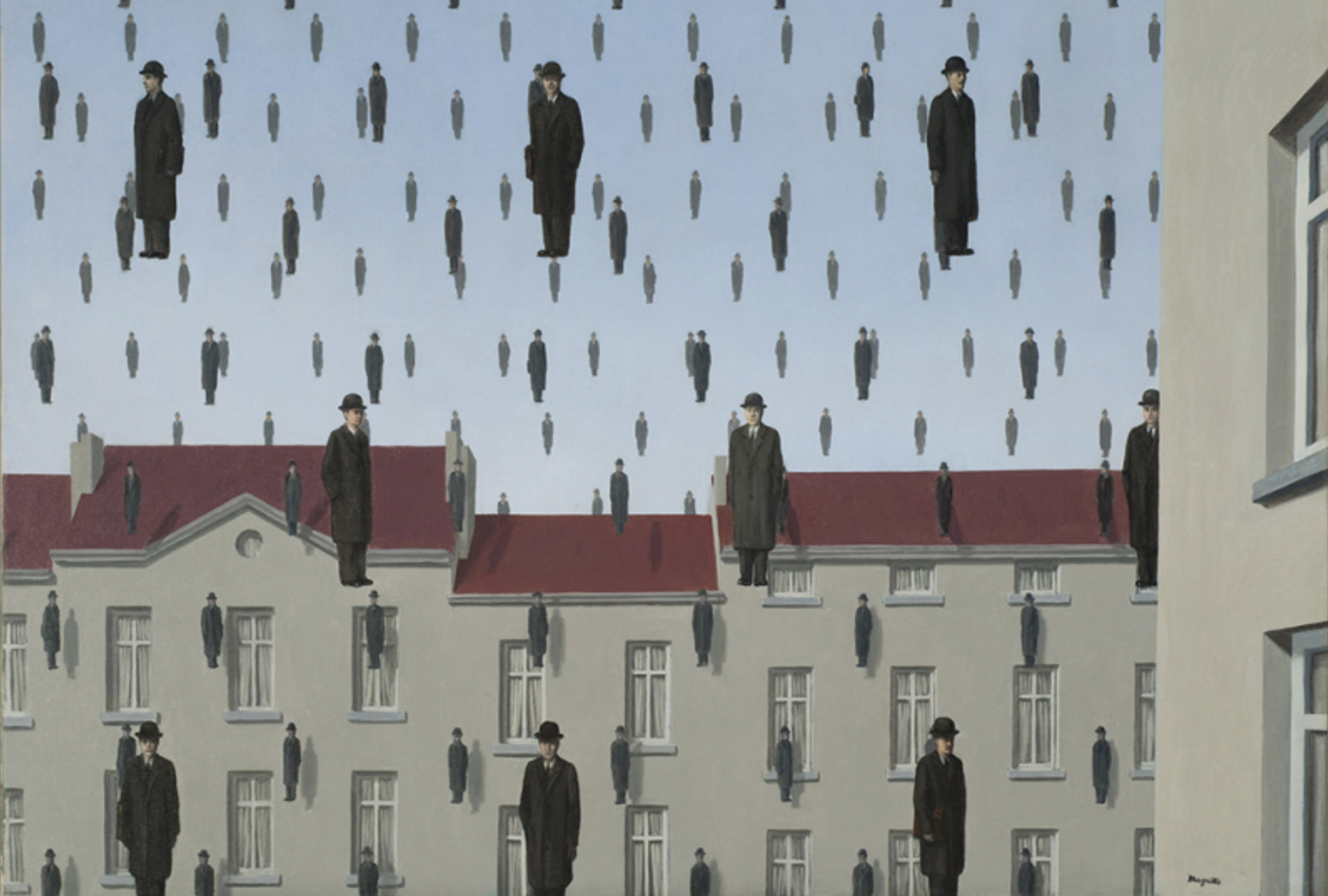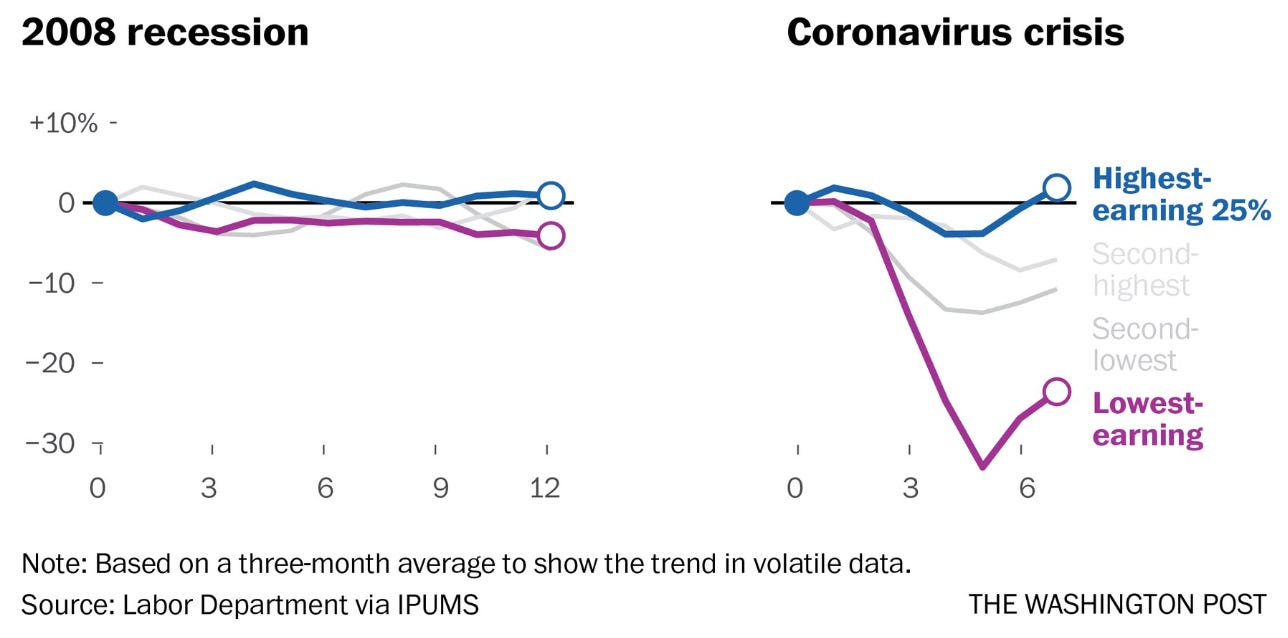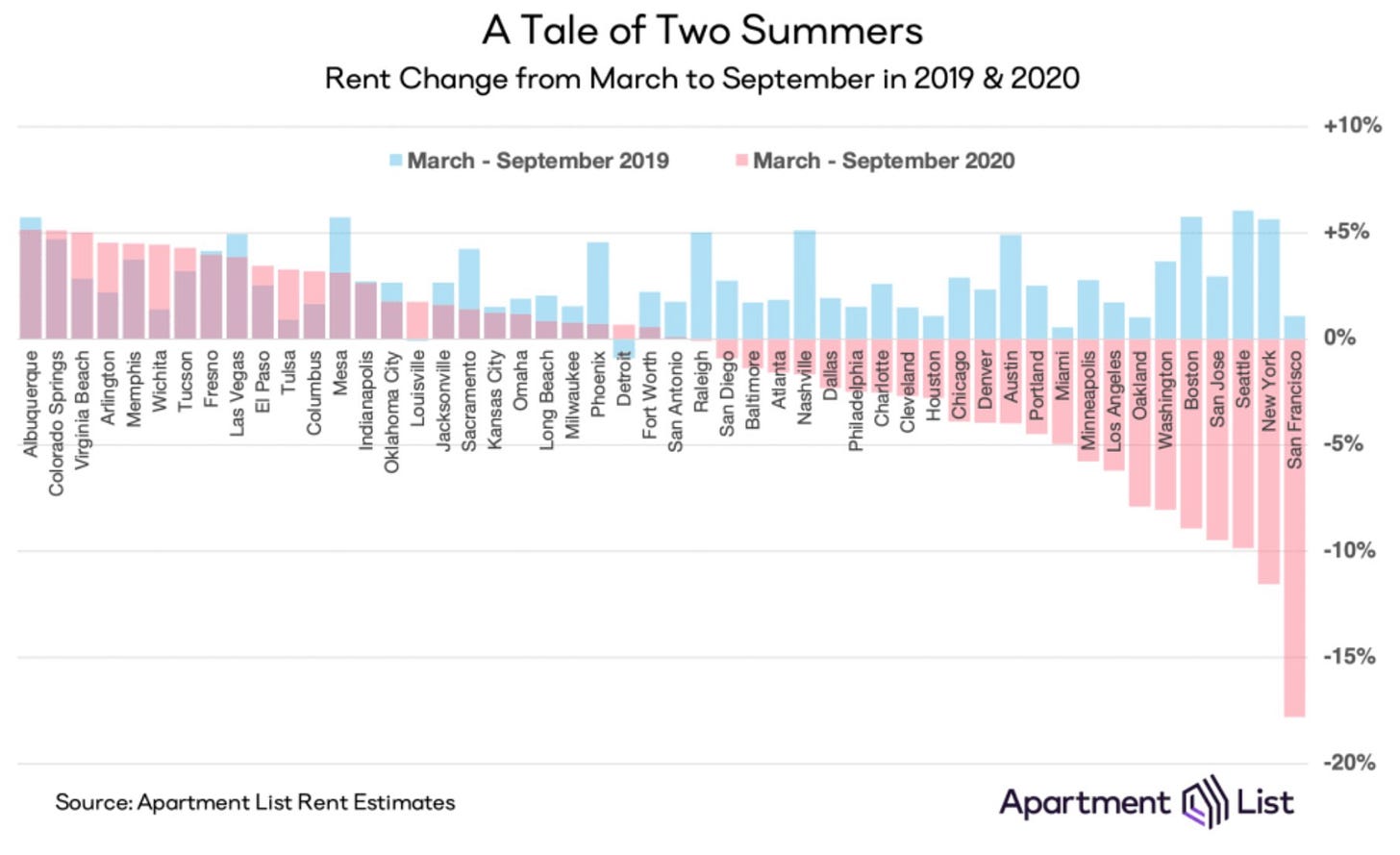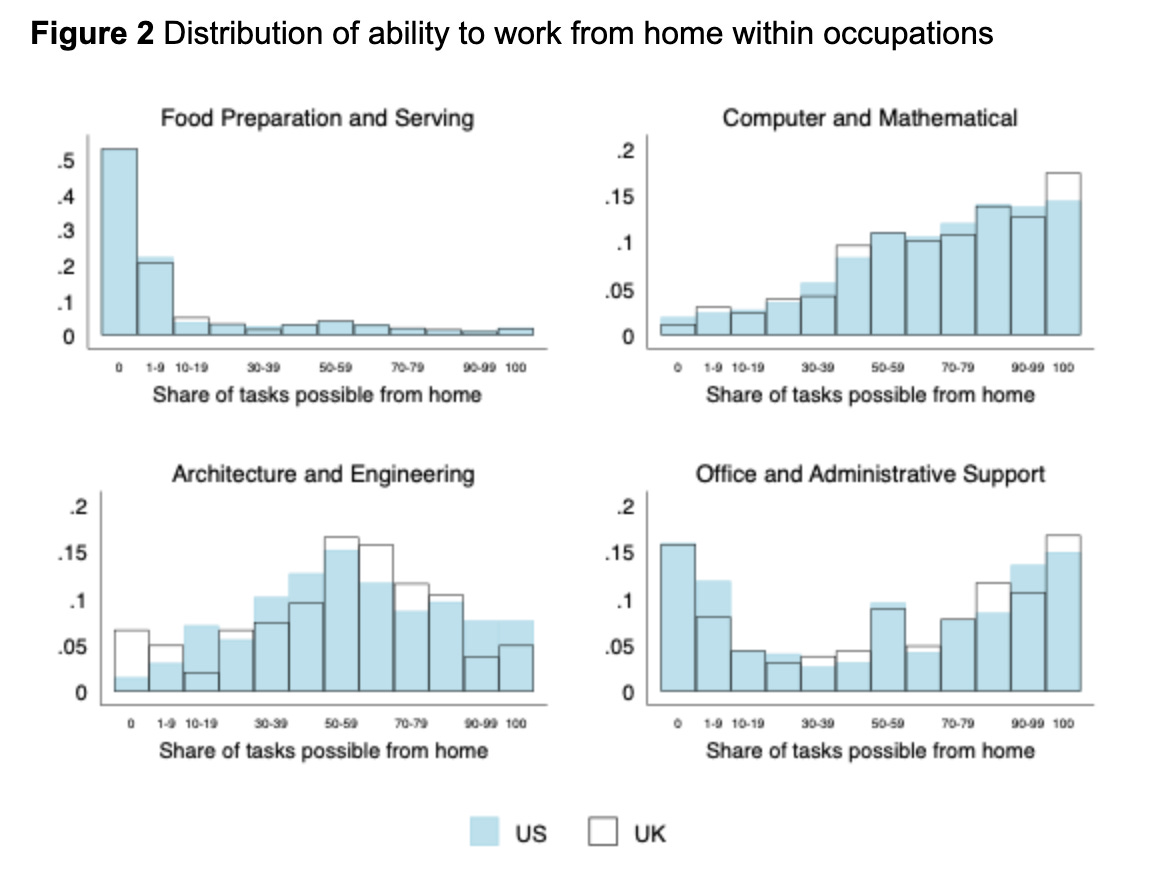The TikTokization of Work
Initially, economic anxiety spares those who can work remotely. Then, it spares no one.

“Life can only be understood backwards; but it must be lived forwards.”
— Søren Kierkegaard
COVID-19 presents us with a unique opportunity to live backwards. Many of the current government policies, economic dynamics, and consumer behaviors dissolve once the virus is under control. Things will not go back to the old normal, but they will try, and they will get close. At least for a while.
But things will not stop there. Trends will resume. Progress will gradually bring us back to where we are now. 2020 gave us an opportunity to live in the future. We cannot stay long, but we can look around and take a few lessons with us back to the past.
What do we see?
The Great Divide
We are in the midst of the deepest and most sudden economic contraction since the Great Depression. But some of us barely noticed.

The chart above shows job growth (or losses) during 2008 and 2020. The Great Financial Crisis hit both low- and high-income earners. High-income jobs dipped and then stabilized and even started growing again within months. Low-income jobs continued to decline at a modest but consistent rate. A somewhat similar dynamic played out during the 2001 recession.
2020 is different. Low-income jobs fell off a cliff and continued to drop for months. The number of high-paying jobs increased as lockdowns loomed, then dipped, and quickly started growing again.
The below chart from former US Treasury economist Ernie Tedeschi offers a more granular view of COVID’s impact on different groups. Between February and April 2020, the number of low-paying jobs decreased by nearly 50%.

This is not another story about the rich and the poor. It is a story about those who are constrained by geography and those who aren’t.
Urban Leaving
Consider the case of New York and San Francisco. People in these two cities enjoy the highest average salaries on earth. The cities are not just home to very wealthy people; they are home to very wealthy working people, employees who get a salary.
New York and San Francisco were hit hardest in 2020. Data from Apartment List shows residential rents in both cities dropped dramatically between March and September.

Rents did not drop because high-income earners are suffering. They dropped because high-income owners are leaving, at least for the time being.
Why are they leaving?
Because they can. High-income earners do not just make more money, they are also much more likely to be able to perform their job remotely. This makes intuitive sense, but a study by researchers from Oxford, Cambridge, and The University of Zurich points backs it up with data. The study points out that “workers’ ability to carry out their tasks from home” was an “important determinant” of how well they fared during COVID.

The chart above shows the level at which different professions tend to depend on physical location. Many of the tasks involved in urban service jobs must be performed on-site. Not surprisingly, most software development and math-intensive work can be done remotely. The picture is more mixed or polarized for architects and administrative workers.
Some knowledge employees can breathe a sigh of relief. But only for now.
The Next Move
Most analyses of remote work tend to conflate jobs with employees. When, say, Facebook announced that 50% of its positions will be remote, we immediately imagine half of the employees moving elsewhere or avoiding the office.
But it’s not the employees who are going remote, it’s the jobs themselves. These positions might be filled by the people who previously filled them; they might also shift to someone else, somewhere else.
Looking at the history of manufacturing jobs makes it easier to grasp what’s coming. When, say, General Motors moved a factory job to China, this didn’t result in someone migrating from Michigan to the more affordable suburbs of Guangdong, China. The job moved, and the old employee stayed put.
As the economist Richard Baldwin points out, globalization is driven by arbitrage. Broadly speaking, if something can be done more cheaply elsewhere, it will ultimately be done there. Many employees can move to a place that allows them to compete better (by lowering their cost of living), but many will stay in place due to considerations that have nothing to do with the job itself: family ties, the cost of moving, language barriers, visa and immigration restrictions.
White-collar jobs are different from blue-collar jobs. It is much easier for a non-manufacturing job to move online — it does not require massive investment in new factories and the reconfiguration of physical supply chains.
On the other hand, the skills required to, say, design a marketing campaign for New Yorkers are not easily found in Guangdong or Minsk. And creative people tend to cluster around other creative people and are more productive when they do so.
But the dynamics of creative work don’t offer much comfort either.
La-La Land
How many actors live in Los Angeles? Scott Frank, an anthropologist focused on the entertainment industry, estimated the number at over 100,000. Out of these, only 20% or so actually work as actors. An even smaller percentage makes a full-time living from acting. A separate study estimates unemployment rates for TV and film actors “hover around 90%” and “as low as 2% of actors are able to make a living out of acting.”
Outcomes in the entertainment industry are governed by power laws. A small group captures most of the rewards. Further, the rich tend to get richer: successful actors tend to get assigned (even) better roles, get even more exposure, and make even more money.
These outcomes happen because the rewards for acting are not constrained by space and time. Once recorded, a film can be played (and monetized) and an unlimited number of times in an unlimited number of places.
Do you see where this is going?
As more and more jobs can be performed remotely, more and more jobs are becoming less constrained by place and time. Remote work is, er, remote. It also tends to be asynchronous. This means that a smaller group of people can capture a bigger share of a given industry’s rewards.
A good designer and software developer or even an accountant can now earn more money than ever. The distribution of outcomes in these professions might never be as skewed as the one for film stars. But it will become a little more similar. Any profession that could be performed beyond the constraints of time and place will become less safe for the average practitioner and offer higher rewards for superstars.
How does one become a superstar?
Brute Force Creativity
In the middle of the 20th Century, Lauren Bacall was one of the greatest film stars on earth. “Stardom,” she said, “isn’t a profession; it’s an accident.” Luck tends to play a big role in distribution that is governed by power laws.
It was hard enough to be a star in the 1950s, but there were still ways to game the system. Moving to LA was one of them. Being around the people that mattered made it more likely that one would be “discovered” at a social event or walking down the street.
Today, the pictures once again got small. Stars no longer emerge on the streets of Los Angeles. They emerge on TikTok. And they are not “discovered” by anyone. Instead, they are picked up by algorithms that give every person a fair shake and then multiply the exposure of those who seem to resonate with viewers.
That’s where we’re all headed. Over time, the rewards for most creative work will become governed by power laws. A smaller group of winners will collect a higher share of the rewards. And over time, algorithms will play a bigger role in determining those winners, shifting power away from old power brokers and hitmakers.
If you don’t believe me, just ask Jeffrey Katzenberg. His app, Quibi, was supposed to be the app that everyone would be talking about in the summer of 2020. Instead, everyone is talking about TikTok. Meanwhile, QuiBi is up for sale with no bidders in sight.
If anyone knew how to create and curate engaging content, it was Katzenberg: the Former Chairman of Disney, Co-Founder of DreamWorks, the producer behind Lion King and The Little Mermaid. Quibi was a brilliant combination of the best talent and technology money could buy. But it didn’t work.
In the battle for America’s attention, a group of Beijing-based engineers defeated Hollywood's finest. How could TikTok’s team figure out which videos would do well in a completely foreign market?
They didn’t even try. Instead, they built an algorithm.
Sunset Boulevard (1950) is perhaps the greatest film ever made about Hollywood and the notion of stardom. In the film, Joe Gillis, a struggling screenwriter, accidentally ends up in the house of Norma Desmond, a washed-up movie star. Gillis immediately recognizes her: “I know your face. You used to be in pictures. you used to be big!” To which Desmond replies, “I am big. It is the pictures that got small.”
Desmond didn’t even realize how small the pictures would become. But now that we all have a little screen in our pocket, we all face the same anxieties — and opportunities — that were previously reserved only for a select few.
Have a great weekend.
P.S.
👓 I spoke to Bloomberg about COVID’s impact on banks and the glass towers they occupy. Money quote: “This is the most radical shift in office life in perhaps a century, certainly since cities started developing financial districts with skyscrapers in them.”
Cover painting by René Magritte © C. Herscovici / Artists Rights Society (ARS), New York
Old/New by Dror Poleg Newsletter
Join the newsletter to receive the latest updates in your inbox.

